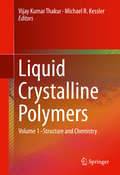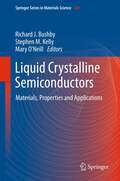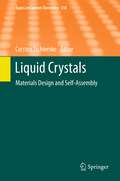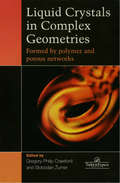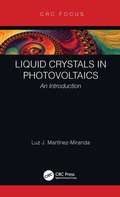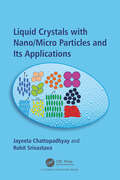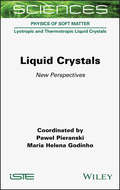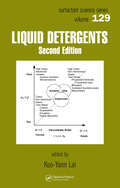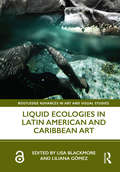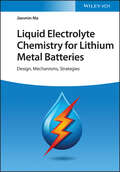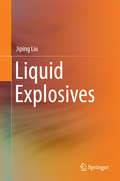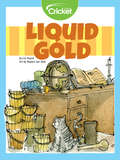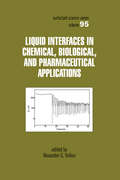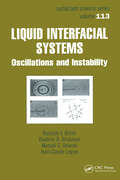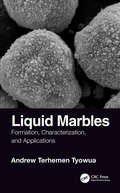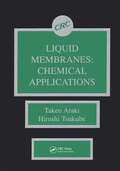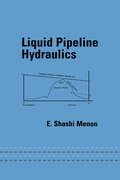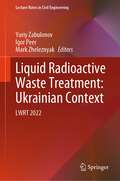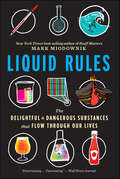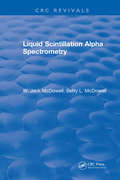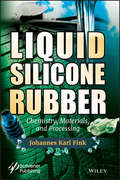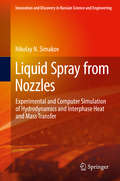- Table View
- List View
Liquid Crystal Sensors (Liquid Crystals Book Series)
by Albert P. H. J. Schenning, Gregory P. Crawford, and Dirk J. BroerLiquid Crystal Sensors discusses novel applications of liquid crystals that lie beyond electrically driven optical switches and displays. The main focus is on recent progress in the area of sensors based on low molar mass and polymer liquid crystals. This area of research became "hot" in recent years since the possibilities for applications of liquid crystal sensors are growing in many areas, ranging from the detection of mechanical displacements to the detection of environmental pollutants and chemical agents. This book is well-suited for students, as well as scientists from different backgrounds. For students and researchers new to the field, it gives a thorough introduction. For experienced researchers it shows the latest breakthroughs and serves as an inspiration for solving problems or sparking new ideas. Key Features: Emphasizes how liquid crystals are extremely sensitive to external stimuli and therefore can be used for the construction of stimuli-responsive devices, such as sensors Includes the contributions of editors who are deeply involved in the field and author chapters on hot topics such as the sensitivity of liquid crystals to pollutants, UV light, and strain Provides an exclusive on LC sensors where having the data in one place will be very useful to the community Gives more information on sensors and broadens the scope by having a contributed volume rather than authored Combines recent data on advances in the area of liquid crystal sensors that includes many types of liquid crystal materials
Liquid Crystalline Polymers
by Vijay Kumar Thakur Michael R. KesslerThis book introduces various applications of liquid crystalline polymers as the emerging new class of high performance novel materials. The authors detail the advantageous properties of these LCs including optical anisotropic, transparency and easy control over structure. This interdisciplinary work includes valuable input from international projects with special focus on the use of liquid crystalline polymers and/or nanocomposites.
Liquid Crystalline Semiconductors
by Mary O'Neill Richard J. Bushby Stephen M. KellyThis is an exciting stage in the development of organic electronics. It is no longer an area of purely academic interest as increasingly real applications are being developed, some of which are beginning to come on-stream. Areas that have already been commercially developed or which are under intensive development include organic light emitting diodes (for flat panel displays and solid state lighting), organic photovoltaic cells, organic thin film transistors (for smart tags and flat panel displays) and sensors. Within the family of organic electronic materials, liquid crystals are relative newcomers. The first electronically conducting liquid crystals were reported in 1988 but already a substantial literature has developed. The advantage of liquid crystalline semiconductors is that they have the easy processability of amorphous and polymeric semiconductors but they usually have higher charge carrier mobilities. Their mobilities do not reach the levels seen in crystalline organics but they circumvent all of the difficult issues of controlling crystal growth and morphology. Liquid crystals self-organise, they can be aligned by fields and surface forces and, because of their fluid nature, defects in liquid crystal structures readily self-heal. With these matters in mind this is an opportune moment to bring together a volume on the subject of 'Liquid Crystalline Semiconductors'. The field is already too large to cover in a comprehensive manner so the aim has been to bring together contributions from leading researchers which cover the main areas of the chemistry (synthesis and structure/function relationships), physics (charge transport mechanisms and optical properties) and potential applications in photovoltaics, organic light emitting diodes (OLEDs) and organic field-effect transistors (OFETs). This book will provide a useful introduction to the field for those in both industry and academia and it is hoped that it will help to stimulate future developments.
Liquid Crystals
by Carsten TschierskeFluorinated Liquid Crystals: Design of Soft Nanostructures and Increased Complexity of Self-Assembly by Perfluorinated Segments, by Carsten Tschierske Liquid Crystalline Crown Ethers, by Martin Kaller and Sabine Laschat Star-Shaped Mesogens - Hekates: The Most Basic Star Structure with Three Branches, by Matthias Lehmann DNA-Based Soft Phases, by Tommaso Bellini, Roberto Cerbino and Giuliano Zanchetta Polar and Apolar Columnar Phases Made of Bent-Core Mesogens, by N. Vaupotič, D. Pociecha and E. Gorecka Spontaneous Achiral Symmetry Breaking in Liquid Crystalline Phases, by H. Takezoe Nanoparticles in Liquid Crystals and Liquid Crystalline Nanoparticles, by Oana Stamatoiu, Javad Mirzaei, Xiang Feng and Torsten Hegmann Stimuli-Responsive Photoluminescent Liquid Crystals, by Shogo Yamane, Kana Tanabe, Yoshimitsu Sagara and Takashi Kato
Liquid Crystals In Complex Geometries: Formed by Polymer And Porous Networks
by Slobodan Žumer Gregory Philip CrawfordFocusing on the applied and basic aspects of confined liquid crystals, this book provides a current treatise of the subject matter and places it in the broader context of electrooptic applications.
Liquid Crystals in Photovoltaics: An Introduction
by Dr. Luz Martinez-MirandaThis book explores why the properties of liquid crystals make them ideal for use in photovoltaic applications. It achieves this by presenting a description of the properties of liquid crystals and how their electronic properties compare to that of polymers used in organic photovoltaics. It explores how the type of liquid crystal chosen can help in improving the efficiency of the photovoltaics. It compares experimental and theoretical ways in which the efficiency is directly or indirectly estimated between the organic photovoltaics and the organic photovoltaics that contain a liquid crystal. It first introduces liquid crystals and their different varieties, before reviewing their electronic transfer properties and how they can improve efficiency. It is an ideal text for graduate students and young researches considering entering the area of photovoltaics - specifically, organic photovoltaics – who do not yet have knowledge of this field. Introduces the field of liquid crystals and provides basic information to those new to the field, in a concise and visual manner Describes which characteristics of a liquid crystal are most advantageous to use in photovoltaics Provides basic knowledge of photovoltaics for those who do not have previous knowledge of how they behave electronically
Liquid Crystals with Nano/Micro Particles and Their Applications
by Rohit Srivastava Jayeeta ChattopadhyayLCs are self-organized anisotropic fluids that are thermodynamically located between the isotropic liquid and the crystalline phase, exhibiting the fluidity of liquids as well as the long-range lattice order that can only be found in crystalline solids. The addition of nanomaterials to a LC material produces a composite or colloidal dispersion and results into a revolutionary change in their applications. This book will discuss the remarkable performances of nano-particle aided liquid crystals in metamaterials, photonics, functionalized polymer fibres, sensing, and medical diagnostics.
Liquid Crystals: New Perspectives (The\liquid Crystals Book Ser.)
by Pawel Pieranski Maria Helena GodinhoThis book on liquid crystals reports on the new perspectives that have been brought about by the recent expansion of frontiers and overhaul of common beliefs.First, it explores the interaction of light with mesophases, when the light or matter is endowed with topological defects. It goes on to show how electrophoresis, electro-osmosis and the swimming of flagellated bacteria are affected by the anisotropic properties of liquid crystals.It also reports on the recent progress in the understanding of thermomechanical and thermohydrodynamical effects in cholesterics and deformed nematics and refutes the common belief that these effects could explain Lehmann’s observations of the rotation of cholesteric droplets subjected to a temperature gradient. It then studies the physics of the dowser texture, which has remarkable properties. This is of particular interest in regards to nematic monopoles, which can easily be generated, set into motion and collided within it.Finally, this book deals with the spontaneous emergence of chirality in nematics made of achiral molecules, and provides a brief historical context of chirality
Liquid Detergents (Surfactant Science)
by Kuo-Yann LaiA best-seller in its first edition, Liquid Detergents, Second Edition captures the most significant advances since 1996, maintaining its reputation as a first-stop reference in all fundamental theories, practical applications, formulation technologies and manufacturing aspects of liquid detergents. Featuring contributions from 22 award-winning, international experts from industry and academia, the book embraces recent advances in the products and technologies of liquid detergents over the last decade and includes more than 30% new material, 1800 up-to-date references, and 300 figures and tables.
Liquid Ecologies in Latin American and Caribbean Art (Routledge Advances in Art and Visual Studies)
by Liliana Gómez Lisa BlackmoreThis interdisciplinary book brings into dialogue research on how different fluids and bodies of water are mobilised as liquid ecologies in the arts in Latin America and the Caribbean. Examining the visual arts, including multimedia installations, performance, photography and film, the chapters place diverse fluids and systems of flow in art historical, ecocritical and cultural analytical contexts. The book will be of interest to scholars of art history, cultural studies, environmental humanities, blue humanities, ecocriticism, Latin American and Caribbean studies, and island studies.
Liquid Electrolyte Chemistry for Lithium Metal Batteries: Design, Mechanisms, Strategies
by Jianmin MaLiquid Electrolyte Chemistry for Lithium Metal Batteries An of-the-moment treatment of liquid electrolytes used in lithium metal batteries Considered by many as the most-promising next-generation batteries, lithium metal batteries have grown in popularity due to their low potential and high capacity. Crucial to the development of this technology, electrolytes can provide efficient electrode electrolyte interfaces, assuring the interconversion of chemical and electrical energy. The quality of electrode electrolyte interphase, in turn, directly governs the performance of batteries. In Liquid Electrolyte Chemistry, provides a comprehensive look at the current understanding and status of research regarding liquid electrolytes for lithium metal batteries. Offering an introduction to lithium-based batteries from development history to their working mechanisms, the book further offers a glimpse at modification strategies of anode electrolyte interphases and cathode electrolytic interphases. More, by discussing the high-voltage electrolytes from their solvents—organic solvents and ionic liquids—to electrolyte additives, the text provides a thorough understanding on liquid electrolyte chemistry in the remit of lithium metal batteries. Liquid Electrolyte Chemistry for Lithium Metal Batteries readers will also find: A unique focus that reviews the development of liquid electrolytes for lithium metal batteries State-of-the-art progress and development of electrolytes for lithium metal batteries Consideration of safety, focusing the design principles of flame retardant and non-flammable electrolytes Principles and progress on low temperature and high temperature electrolytes Liquid Electrolyte Chemistry for Lithium Metal Batteries is a useful reference for electrochemists, solid state chemists, inorganic chemists, physical chemists, surface chemists, materials scientists, and the libraries that supply them.
Liquid Explosives
by Jiping LiuThe book drawing on the author's nearly half a century of energetic materials research experience intends to systematically review the global researches on liquid explosives. The book focuses on the study of the conception, explosion mechanism, properties and preparation of liquid explosives. It provides a combination of theoretical knowledge and practical examples in a reader-friendly style. The book is likely to be interest of university researchers and graduate students in the fields of energetic materials, blasting engineering and mining.
Liquid Gold
by Liz HuyckWhat would you give for a bucket of pee? You might be surprised—pee is full of useful stuff! It’s had a lot of uses throughout history. See how people have used urine for important aspects of life— including cleaning your clothes and brushing your teeth!
Liquid Interfaces In Chemical, Biological And Pharmaceutical Applications (Surfactant Science)
by Alexander G. VolkovProvides a comprehensive treatment of surface chemistry and its applications to chemical engineering, biology, and medicine. Focuses on the chmical and physical structure of oil-water interfaces and membrane surfaces. Details interfacial potentials, ion solvation, and electrostatic instabilities in double layers.
Liquid Interfacial Systems: Oscillations and Instability (Surfactant Science)
by Manuel G. Velarde Rudolph V. Birikh Vladimir A. Briskman Jean-Claude LegrosDespite factoring in countless natural, biological, and industrial processes, fixed attention on the singular attributes and behavior of fluids near or at interfaces has not received enough attention in the surface science literature. Liquid Interfacial Systems assembles and analyzes concepts and findings as an inclusive summation of fluid-fluid interfacial phenomena. This book covers excitation, stabilization, and suppression of instability at liquid interfaces. From the influential original research and scholarship of leaders in the discipline comes a volume to impart and explain definitions, scales, governing equations, and boundary conditions used in liquid interfacial system research.
Liquid Marbles: Formation, Characterization, and Applications
by Andrew T. TyowuaCertain small solid particles are surface-active at fluid interfaces and thus are able to stabilize materials previously considered impossible to stabilize in their absence. Liquid marbles, particle-coated non-sticking liquid droplets, represent one of these materials. Preparation of liquid marbles was described only about 15 years ago and they are now widely studied by many research groups and numerous applications of liquid marbles have been advanced. The book is written for postgraduates and researchers working on the area who are training to become chemists, soft matter physicists, materials scientists, and engineers.
Liquid Membranes: Chemical Applications
by Takeo Araki Hiroshi TsukubeThis interesting work extensively describes newer applications of liquid membrane systems which contain molecular and/or ion recognizing carrier compounds and the related characteristic membrane materials. This volume focuses on the current knowledge about chemistry, biology and related technology of liquid membranes. It reviews the most recent advances in design and characteristics of synthetic liquid membrane transport. Additionally, this fascinating reference discusses up-to-date topics in the analytical and separation science, plus biomimetic membrane technology. Because this book is presented in a compact, understandable format, readers can start from biological cell membranes, then net aspects of host-guest chemistry for effective recognition of ions and molecules, followed by its application for artificial sensors-such as neuro-systems, functionalized new detergents, mechanochemical systems, and separation chemistry. This publication is ideal for graduate-level students and will stimulate university and industry researchers.
Liquid Phase Oxidation via Heterogeneous Catalysis: Organic Synthesis and Industrial Applications
by Mario G. Clerici Oxana A. KholdeevaSets the stage for environmentally friendly industrial organic syntheses From basic principles to new and emerging industrial applications, this book offers comprehensive coverage of heterogeneous liquid-phase selective oxidation catalysis. It fully examines the synthesis, characterization, and application of catalytic materials for environmentally friendly organic syntheses. Readers will find coverage of all the important classes of catalysts, with an emphasis on their stability and reusability. Liquid Phase Oxidation via Heterogeneous Catalysis features contributions from an international team of leading chemists representing both industry and academia. The book begins with a chapter on environmentally benign oxidants and then covers: Selective oxidations catalyzed by TS-1 and other metal-substituted zeolites Selective catalytic oxidation over ordered nanoporous metallo-aluminophosphates Selective oxidations catalyzed by mesoporous metal-silicates Liquid phase oxidation of organic compounds by supported metal-based catalysts Selective liquid phase oxidations in the presence of supported polyoxometalates Selective oxidations catalyzed by supported metal complexes Liquid phase oxidation of organic compounds by metal-organic frameworks Heterogeneous photocatalysis for selective oxidations with molecular oxygen All the chapters dedicated to specific types of catalysts follow a similar organization and structure, making it easy to compare the advantages and disadvantages of different catalysts. The final chapter examines the latest industrial applications, such as the production of catechol and hydroquinone, cyclohexanone oxime, and propylene oxide. With its unique focus on liquid phase heterogeneous oxidation catalysis, this book enables researchers in organic synthesis and oxidation catalysis to explore and develop promising new catalytic materials and synthetic routes for a broad range of industrial applications.
Liquid Pipeline Hydraulics
by E. Shashi MenonAvoiding lengthy mathematical discussions, this reference specifically addresses issues affecting the day-to-day practices of those who design, operate, and purchase liquid pipelines in the oil, water, and process industries. Liquid Pipeline Hydraulics supplies an abundance of practical examples and applications for an in-depth understanding of liq
Liquid Radioactive Waste Treatment: LWRT 2022 (Lecture Notes in Civil Engineering #469)
by Yuriy Zabulonov Igor Peer Mark ZheleznyakThis book presents the latest scientific advancements and innovative R&D solutions for the treatment of liquid radioactive waste in the context of practical threats in Ukraine. It includes research and engineering insights from the International Conference “Liquid Radioactive Waste Treatment: Ukrainian Context” (LWRT 2022), which was held in Kyiv, Ukraine on June 30, 2022. This publication covers a wide range of topics related to the treatment and management of radioactive waste, with a particular emphasis on safety considerations. The included articles also explore various aspects of environmental engineering and innovative R&D solutions, as well as the sustainability challenges associated with radioactive waste in the context of postwar reconstruction efforts. The contributions featured in this publication were selected through a rigorous international peer-review process. The carefully curated collection of articles showcases a diverse range of exciting ideas, poised to inspire novel research directions and stimulate interdisciplinary collaborations.
Liquid Rules: The Delightful and Dangerous Substances That Flow Through Our Lives
by Mark MiodownikThe New York Times–bestselling author of Stuff Matters offers an “entertaining discussion of the various ways our lives are enriched by fluids” (The Wall Street Journal).We know that we need water to survive, and that, for some of us, a cup of coffee or a glass of wine can feel just as vital. But do we really understand how much we rely on liquids, or their destructive power?Set on one of the author's transatlantic flights, Liquid Rules offers readers a tour of these formless substances, told through the language of molecules, droplets, heartbeats, and ocean waves. We encounter fluids within the plane—from hand soap to liquid crystal display screens—and without: in the volcanoes of Iceland, the frozen expanse of Greenland, and the marvelous California coastline. We come to see liquids with wonder and fascination, and to understand their potential for death and destruction.Just as in his bestselling, award-winning Stuff Matters, Mark Miodownik’s unique brand of scientific storytelling brings his subject to life in ways that will inform and amuse science buffs and lay readers alike.Once again, [Miodownik] has written a book much like the substances it describes: exciting, anarchic and surprising. Like the sea, it covers a lot of ground. And like a perfectly made cup of tea, it is warm, comforting and very refreshing.” —The Guardian“At a time when technology, science, and public policy are often at odds, Miodownik adds to our understanding of the physical world with humor and sound science.” —Science
Liquid Scintillation Alpha Spectrometry
by W. McDowellAlpha liquid scintillation was developed to obtain accurate analytical determinations of alpha-emitting nuclides where no other methods were sufficiently accurate. With the present emphasis on clean-up of radiation contamination, alpha liquid scintillation has become an important tool in the determination of low concentrations of alpha-emitting nuclides. This book is the first to address the subject of alpha liquid scintillation in its entirety. It also examines how alpha spectrometry by liquid scintillation can be done without interference from beta/gamma radiation. Scientists interested in the analysis of alpha-emitting nuclides for environmental monitoring, remediation clean-up, accountability, and research will find this to be a valuable book.
Liquid Silicone Rubber: Chemistry, Materials, and Processing
by Johannes Karl FinkThe scientific literature with respect to liquid silicone rubbers is collected in this monograph. The text focuses on the fundamental issues such as properties, curing methods, special materials, as well as the latest development and provides a broad overview of the materials used therein. In particular, materials and compositions for liquid functional rubbers are discussed. Also, methods of curing and special properties are described, such as tracking and erosion resistance, adhesion properties, storage and thermal stability. Methods of curing are precision casting, hybrid additive manufacturing, peroxide curing, ultraviolet curing, liquid injection molding, or hot embossing. The book includes applications including automotive and underwater applications, electrical and optical uses, as well as medical uses.
Liquid Spray from Nozzles: Experimental and Computer Simulation of Hydrodynamics and Interphase Heat and Mass Transfer (Innovation and Discovery in Russian Science and Engineering)
by Nikolay N. SimakovThis book advances a new view of phenomena associated with the spray of liquids from a nozzle in a gas. New results of experimental studies and numerical simulation of the hydrodynamics of an emerging two-phase flow and accompanying interphase heat and mass transfer therein are presented. The book is ideal for specialists who develop and use technologies involving the spraying of liquids in a gas, such as burning and pyrolysis of liquid hydrocarbons, granulation and drying of polymers, and dust and gas scrubbing.
Liquid Surfaces and Interfaces
by Peter S. Pershan Mark L. SchlossmanThe availability of synchrotron x-ray sources and the subsequent developments described in this book have led to substantial progress in our understanding of molecular ordering at liquid interfaces. This practical guide enables graduate students and researchers working in physics, chemistry, biology and materials science to understand and carry out experimental investigations into the basic physical and chemical properties of liquid surfaces and interfaces. The book examines the surfaces of bulk liquids, thin wetting films and buried liquid-liquid interfaces. It discusses experiments on simple and complex fluids, including pure water and organic liquids, liquid crystals, liquid metals, electrified liquid-liquid interfaces and interfacial monolayers of amphiphiles, nanoparticles, polymers and biomolecules. A detailed description of the apparatus and techniques required for these experiments is provided, and theoretical approaches to data analysis are described, including approximate methods such as the Master formula, the Born approximation, Parratt's algorithm and the Distorted Wave Approximation.

